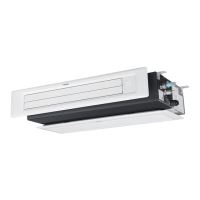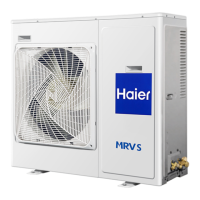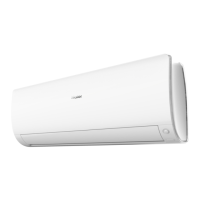226
Fig.6
Gasket (purchased locally)
Double nuts (purchased locally)
Lifting bolt (purchased locally)
Nut (purchased locally)
Valve box
10-15mm
Lifting tool
4. Refrigerant pipe Installation
• Pipes between the outdoor unit and valve box, selection of refrigerant branching suite, and the Pipe between
refrigerant branching suites and the indoor units, please refer to the installation instructions or equipment design
data attached to the outdoor unit.
• Before Installation, make sure the type of the refrigerant to be used is R410A. (If a refrigerant other than this type
is used, It cannot run properly)
• Please provide thermal insulation at the high-pressure gas pipe, suction gas pipe,, liquid pipe and oil equalizing
pipe (pipes for outdoor units in case of multi-split system) and the connections between these pipes. In the
absence of thermal insulation, liquid leakage and scalding may happen. Particularly when the high-pressure
gas pipe delivers indrawn air under full-refrigeration condition, it needs the same thermal insulation as does the
suction gas pipe. Besides, high-pressure gas pipe and suction gas pipe are to deliver high-pressure gas, thus
please provide thermal insulation material that can sustain temperature over 120 °C.
• Enhance the thermal insulation material based on the installation environment. The indicators are shown below.
For RH75%–80% at 30°C: over 15 mm thick.
For over 80% at 30°C: over 20 mm thick.
If not reinforced, the thermal insulation material surface is prone to condensation. Please refer to the equipment
design data for further details.
• The high-pressure gas pipe, suction gas pipe, liquid pipe must be provided with reliable thermal insulation. In the
absence of thermal insulation, liquid leakage may happen.
• The outdoor unit is already lled with refrigerant.
• To connect the pipes to valve box or remove them from valve box, do use both spanner and torque wrench, as
shown in the Fig.7.
• Apply refrigerant oil to inside and outside of the are. Screw it for 3 to 4 rounds with hands and then tighten it.
• Determine the tightening torque. (Excessive tightening may damage the nuts and hence cause leakage)
• Check the connecting pipes for gas leakage and then x the thermal insulation, as shown in the Fig.8
• Only use sealing gasket to wrap the part jointing between the gas pipe and thermal insulation.
• For pipe cutter and are tool, please use R410A special tools.
Paste the refrigerant oil here
Torque spanner
Spanner
Pipe joint
Cone nut
Fig.7
Fig.8
HP gas pipe
Liquid pipe
Suction gas pipe
(for HP gas pipe)
Heat insulation(accessory)
Heat insulation(accessory)
Heat insulation (accessory)
(for Suction gas pipe)
(for liquid pipe)
Middle size seal cushion (accessory)
(Use seal cushion to bind the pipe joint)

